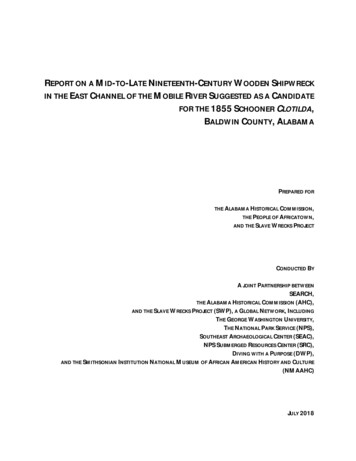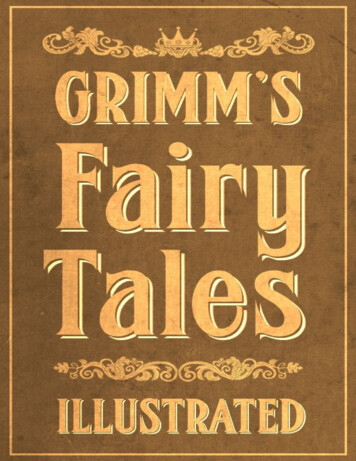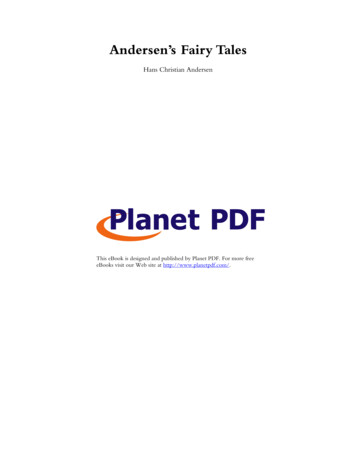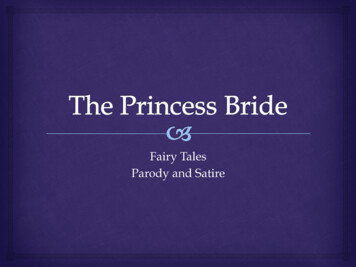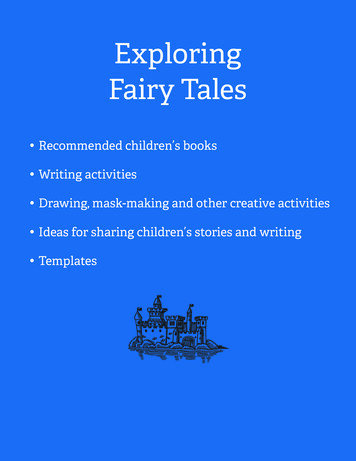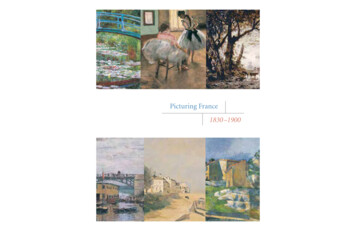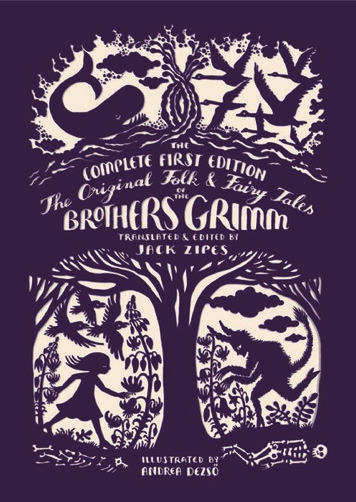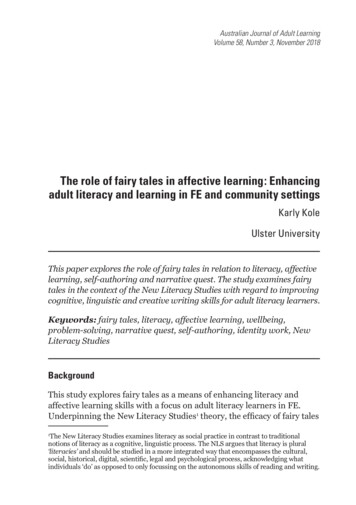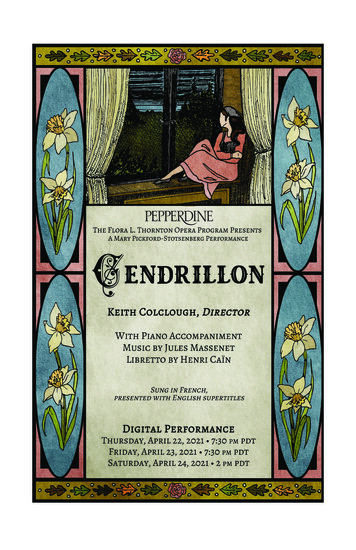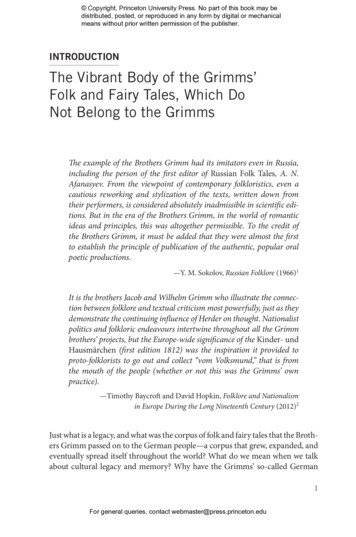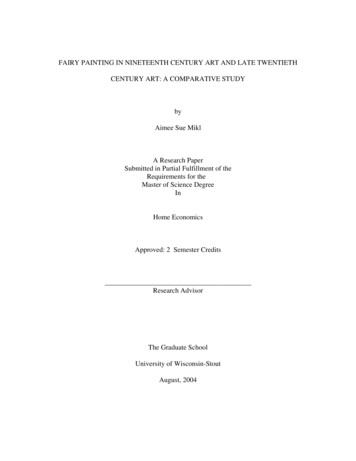
Transcription
FAIRY PAINTING IN NINETEENTH CENTURY ART AND LATE TWENTIETHCENTURY ART: A COMPARATIVE STUDYbyAimee Sue MiklA Research PaperSubmitted in Partial Fulfillment of theRequirements for theMaster of Science DegreeInHome EconomicsApproved: 2 Semester CreditsResearch AdvisorThe Graduate SchoolUniversity of Wisconsin-StoutAugust, 2004
iiThe Graduate SchoolUniversity of Wisconsin StoutMenomonie, WI 54751ABSTRACTMiklAimee(Writer) (Last Name)(First Name)S.(Middle Initial)Fairies in 19th Century art and late 20th Century art: A comparative study(Title)Home Economics,(Graduate Program)Dr. Rita Christoffersen,(Research Advisor)August, 2004,(Month/Year)(# of pages)American Psychological Association, 5th edition(Name of Style Manual Used in this Study)The history of fairies has existed for centuries and will continue to exist as long as people remainwho are fascinated by them and are compelled to put pen to paper and brush to canvas. Duringthe nineteenth century, there was an explosion of fairies depicted in art. Nineteenth centuryartists like Fitzgerald, Dadd, and Doyle used their art to express the societal influences oftheatre, ballet, sex, drugs, and technological advances brought about by the industrial revolution.The late twentieth century artists like Brown, Froud, and Law also drew inspiration fromliterature, advances in societal norms allowing for open expression of sexuality, technologicaladvances which provided access to information, and from each other. However, unlike thenineteenth century artists, the late twentieth century artists openly expressed through their art theinfluence of sex.
iiiThis research compares selected late twentieth century artists depicting fairy illustrationswith selected nineteenth century artists. Influences that had a direct effect on fairy art weretheatre, ballet, literature, technology and society as a whole. Because these influences were notstagnant, it is necessary to discover whether the depiction of fairies has evolved or remained thesame.
ivACKNOWLEDGEMENTSI would like that thank Rita, my thesis advisor, for putting up with my procrastination. To myfamily for saying “isn’t that paper done yet!” To Patrick and Johnne who kept on my case tofinish. Thanks to Lori Jean for being my editor and to all the other people who kept up theencouraging words.
vTABLE OF CONTENTSABSTRACT. iiLIST OF FIGURES . viiCHAPTER ONE: INTRODUCTION.1Statement of problem .2Purpose of the study .2Research objectives.3Limitations of the study.3Definition of terms .3CHAPTER TWO: LITERATURE REVIEW .5Fairy History .5Fairies in Theatre and Ballet.6Fairies in nineteenth century literature .7John Fitzgerald.7Richard Dadd .8Richard Doyal .10Fairies in late twentieth century literature.10Amy Brown .11Brian Froud .12Stephanie Law .13Summary .13CHAPTER THREE: METHODOLGY .14Introduction .14Method of study.14CHAPTER FOUR: DISCUSSION .16Summary of findings .16Nineteenth century artists .16Late twentieth century artists.24Summary .34
viCHAPTER FIVE: SUMMARY, CONCLUSION AND RECOMMENDATIONS.36Summary .36Conclusions.36Recommendations .36REFERENCES .38
viiLIST OF FIGURESFigure 1The stuff dreams are made of, 1858Figure 2The captive robin, 1865Figure 3Come onto these yellow sands, 1841Figure 4Contradiction: Oberon and Titania, 1854-1858Figure 5The fairy tree, 1865Figure 6Doormouse’s house warming party, Copyright Amy BrownFigure 7The autumn court, Copyright Amy BrownFigure 8The dressing of a salad, from Good Faeries Bad Faeries, copyright Brian FroudFigure 9Nippers in the orchard, from Good Faeries Bad Faeries, copyright Brian FroudFigure 10Queen of the bad faeries, from Good Faeries Bad Faeries, copyright Brian FroudFigure 11Seeking the mothqueen, Copyright Stephanie Pui Mun LawFigure 12And such is the way of the faeries, Copyright Stephanie Pui Mun Law
1CHAPTER ONEINTRODUCTIONFor centuries, storytellers, artists, and poets have been fascinated by the idea of a secret,separate race of beings existing close to humans on another plane. The belief of fairies hasmainly survived in the rural areas of Celtic lands like Ireland and Isle of Man, with their manytales of fairy happenings. Many artists and authors ranging from Chaucer and Shakespeare tothe present time have imagined who fairies are and what they may have looked like. “Faery folkhave been distorted and misunderstood by those who never bothered to know them properly”(McHargue, 1972, p. 31). As early as the sixteenth century, artists and authors had so manyideas of what fairies should look like, that they almost erased the images of fairies that werecreated by folktales and myths. Over time, the images of fairies have been distorted andexploited to such an extent that they are now the small cute beings, such as Tinkerbelle from thestory Peter Pan, that appear in art and fiction today.Although fairy depiction had existed prior to the nineteenth century, it was not until thenthat a movement began, which concentrated on fairy painting. When describing this movement,Jeremy Maas (1997) states that:“no other type of painting concentrates so many of the opposing elements in theVictorian Psyche: the desire to escape the drear hardships of daily existence; the stirringsof new attitudes towards sex, stifled by religious dogma; a passion for the unknown;psychological retreat from scientific discovery; the latent revulsion against the exactitudeof the new invention of photography.” (p. 11).Like Maas, Nicola Brown (2001) has a similar theory that Victorians tried to escapemodernity through fairies and imagination. Similarly, Christopher Wood (2000) suggestsVictorian art gives way to reveal sex, drugs, and nudity all under the title of art.
2The three artists chosen from the nineteenth century for this study, John AnsterFitzgerald, Richard Doyle, and Richard Dadd all have one thing in common; they have paintedfairies. Each artist illustrates fairies with different mediums of color and texture.Late twentieth century artists, Amy Brown, Stephanie Law, and Brian Froud alsoillustrate fairies. They, like the nineteenth century artists, illustrate fairies in their owntechnique; each person pulls inspiration from different sources.According to her personal website (2004), Amy Brown’s influence for painting fairieshas been Brian Froud and Micheal Parkes. She also has been inspired by the urban fantasystories of Charles Delint and haunting music of Loreena McKinnitt.Stephanie Law’s inspiration stems from mythology, legend, and folklore. She has alsobeen inspired by the art of Impressionists, Pre-Raphaelites, and Surrealists. Stephanie, as ayoung girl, was first introduced to fairies and fantasy by a friend through the books Chronicles ofNarnia by C.S. Lewis.Brian Froud is the author of two fairy books titled, Faeries, and Good Faeries/BadFaeries. Brian states his illustrations are not drawn from specific stories or folklore texts; ratherthey are images painted by intuition and visions ( Froud, 1998).Statement of the problemThis research compares selected late twentieth century artists depicting fairy illustrationswith selected nineteenth century artists. Influences that had a direct effect on fairy art weretheatre, ballet, literature, technology and society as a whole. Because these influences were notstagnant, it is necessary to discover whether the depiction of fairies has evolved or remained thesame.
3Purpose of the StudyThe purpose of this study was to research the influences and motivations on nineteenthcentury and late twentieth century paintings and depictions of fairies in order to determinewhether they were similar or divergent. Art historically keeps impacting future generations.Nineteenth century artists drew inspiration from theatre and ballet. Sex, drugs, and advances intechnology were hidden in the background.In the late twentieth century sex, drugs, took a huge leap into the open and great advancesin technology took place. Drugs were illegal but widely used, and sex was used to sell,especially in advertising. Artists no longer drew inspiration only from theatre and ballet butfrom the historical artists themselves.Research ObjectivesThe objectives of this research were to:1. Select illustrators who have produced visual representations of fairies which werepainted in the nineteenth and late twentieth century.2. Compare selected fairy paintings of the nineteenth and late twentieth centuries.3. Interpret influences and motivation on the nineteenth and late twentieth centuryartists’ depictions of fairies.Limitations of the study1. This study was limited to selected artists who illustrated fairies during the nineteenthand late twentieth centuries.2. In this study, the artists chosen were limited to six, three from each century.
43. This study is subjective in nature. Even though the writer has researched others’ andtheir analyses of fairy illustration, the evidence chosen could easily be skewed to matchthe writer’s viewpoint. The writer has attempted to be as objective as possible whencomparing selected paintings.Definition of termsFairy – A mythical being of folklore and romance usually having diminutive human formand magic powers (Mish, pg 417).Nineteenth Century – Years dating between 1800-1899, a time when fairy lore anddepiction was widely celebrated.Late Twentieth Century – Years dating between 1960-1999.
5CHAPTER TWOLITERATURE REVIEWThe literature review will discuss fairies in general, influences from theatre, ballet, andliterature and other societal influences, followed by information regarding fairies in nineteenthcentury art by Fitzgerald, Doyle, and Dadd. In addition, late twentieth century art by Brown,Law, and Froud was studied and evaluated. Literature from the nineteenth and late twentiethcenturies discussed a number of great fairy artists. The artists were chosen for this studyaccording to who held the greatest popularity in fairy art literature.Fairy HistoryThe word fairy, according to Froud (1998), was originally derived from the Latin wordfatum which means destiny or enchantment. From there, the word fatum turned into Fee inFrench then into Fay or Fae in English. Froud (1998) stated that by the seventeenth centurythere were many different kinds of fairy words like: faire folk, fairfolks, farefolkis, pharie,pheries, farie, fairy, fairie, fairye, and faery. There are many spellings of the word fairy as wellas many myths of origin. An Icelandic version of fairy origin from Froud is as follows:“Eva was washing her children by the river when God spoke to her. In her aweand fear she hid those children she had not already washed. God asked if all her childrenwere there and she replied that they were. He then declared that those children who hidfrom him would be hidden from man.” (Froud, 1978, p.4.).This myth describes one reason why humans can not see fairies, which in turn makes fairiesmagical and fascinating to many.In Ireland, fairies are called the Tuatha De Danann and it is interesting to note that inancient Irish manuscripts, the gods of the pre-Christian Celts had the same name (McHargue,1972). The theory of fairies living underground could have come about when old beliefs wereno longer accepted. Many fairy folk stories have survived mainly in the Celtic lands.
6Fairies in Theatre and BalletFairies were popular subjects of the theater, art and music of the nineteenth century. Thecenter of the Victorian subconscious was fairy painting (Maas, 1997, p. 11). Fairy painters ofthis era loved theatre and ballet. Theatre and ballet created an illusion of life so people couldescape from their everyday lives. Nudity in fairy painting ranged from the grotesquely erotic toidealized visions (Maas, 1997). Shakespeare’s plays, especially A Midsummer Night Dream andthe Tempest, also helped influence the Victorian fairy craze by describing the fairies in his plays.Shakespeare made great use of fairy literature and traditional English folklore (Wood, 2000).Nineteenth century literature provided subject material, but the visual impact of pantomime,ballet and opera is apparent in the fairy paintings from the nineteenth century.Spirtualism, another nineteenth century stimulus, gave the artist and his public a commonground to share. The first mediums, individuals who communicated with the spirit world,surfaced during this time. High society ladies invited others to “tea and table-turning”, where amedium was invited over for tea and to communicate with the spirit world for the guests. TheSociety for Psychical Research was also founded, with members including a bishop and aminister of the crown (Maas, 1997).The romantic movement in ballet created more imagination because during the nineteenthcentury one of the main themes “was the supernatural, in which a spirit forms a relationship witha mortal” (Wood, 2000, p 13). Fairies have always been associated with music and dancing. Itwas from ballet that nineteenth century painters drew their imagery (Wood, 2000). People wereastonished by the ability of one being able to walk across the floor on ones toes which in turn,affected the way human movement was represented by artists. New inventions in stage craft and
7set design also increased the public’s appetite for spectacle and illusion. The same elaboratestaging continued to characterize theatre until the end of the nineteenth century (Wood, 2000).Fairies in nineteenth century literatureFairy tales written in the nineteenth century were for the enjoyment of children, yetbecause fairies were so popular, it is said that adults also read them (Trimpe, 1997). The bookstitled Grimm’s Fairy Tales and Hans Christian Anderson’s Fairy Tales helped create thenineteenth century fairy craze. Hans Christian Andersen’s book, Fairy Tales was not publisheduntil the 1840’s. Hans Christian Andersen and Grimm’s stories became the most popular of allnineteenth century children’s books, endlessly republished and illustrated by many differentartists. After the nineteenth century, “it was as though artists had become reluctant to exercisetheir former willing suspension of disbelief and had banished fairies to their domain, the nursery.The fairy kingdom was more and more linked to children’s fairy tales, to the world of Alice inWonderland, The Water Babies, and Peter Pan” (Maas, 1997, p. 21). Studies in psychology onvisual perception and the invention of photography and moving pictures threatened the reality offairies (Gere, 1997).John Fitzgerald (British 1823-1906)Fitzgerald’s paintings are indeed spectacular and full of color. He devoted most of his artcareer to fairy painting, he was known as ‘Fairy Fitzgerald’ (Wood, 2000). All Fitzgerald’s fairypaintings are dated 1850-1860. According to Maas,“Fitzgerald’s fairy paintings, at their best, present us with a world of vivid yetharmonious colors. They are inhabited by beautiful fairies with translucent wings anddiaphanous garments, wood sprites with glittering hair, goblins with fantastic heads,sleeping, walking, dreaming, or tormenting mice or birds. Deep sunless forest glades orbathed in moonlight, they are framed by honeysuckle, cowslips and morning glory,‘nodding violets’, ‘sweet musk-roses’ and wild thyme’, entwined with writhing branches.Any eroticism is discreetly veiled and transmuted into suggestions of love and marriage”(Mass, 1997, p. 18).
8Wood (2000) considers Fitzgerald to be one of the greatest and most prolific of thenineteenth century fairy painters. Fitzgerald opens a window into the nineteenth centurysubconscious with all its dark secrets through his art (Wood, 2000).Another factor of fairy appearance in nineteenth century art is the availability of opium,morphine, cocaine, and chloroform (Gere, 1997). These drugs were used in the nineteenthcentury by many people. The sensation the drugs produced could have given artists likeFitzgerald the feeling of an out of body experience where they were looking at themselves whilepainting or dreaming in the drug haze, imagining the fairies and creatures floating in the airabove them. People from this age were of the opinion that the pleasures of smoking and inhalingdifferent kinds of drugs were no more wrong than smoking tobacco (Gere, 1997). The use ofdrugs to explore ones’ more creative side came to a halt around 1868 with the Pharmacy Act.Pharmacists could no longer buy as much opium as they wanted because of legal limitations(Wood, 2000).Fitzgerald did not use Shakespeare as inspiration. He used his imagination and subjectsfrom folk tales to show pure spectacle from the stage. He usually painted nocturnalenvironments, brilliantly lit, clearly inspired from the invention and use of gaslight in the theatre.Fitzgerald’s pictures hint at erotic symbolism. His paintings do not supply nude fairies likeDadd’s Come onto these yellow sands, yet show seductiveness. Even more, he shows a secretplace where drugs influenced his series of dream paintings. The use of drugs gave colors moreintensity; fantastic dreams came from an opium induced sleep (Maas, 1997).Richard Dadd (British 1819-1886)Richard Dadd’s story is unique. He was regarded as one of the most promising artists ofhis time, liked for his cheerfulness and good nature (Kimmelman, 1998). While Dadd was
9traveling, a companion noticed he was having delusions and sent him home. His father, onadvice from a doctor, thought taking him to the country would help him get better. While in thecountry, Dadd stabbed and killed his father and then fled to France. He had intentions ofmurdering the Emperor of Austria, but ended up stabbing a fellow traveler. He later confessedthat he thought his father was the devil and that he had a duty to perform from the God Osiris to“exterminate the men most possessed with the demon” (Wood, 2000, p. 81). He was laterdiagnosed with bipolar manic depression. During his stay in mental institutions, encouraged byhis doctors, Dadd painted two of the finest nineteenth century paintings. The last painting Daddfinished before he went mad was called Come onto these yellow sands. The painting’s namecomes from an excerpt in Shakespeare’s play, Tempest (Blakemore, 1997, p. 1667).Ariel’s first song in “The Tempest” says:‘Come unto these yellow sandsAnd then take these hands:Curtsied when you have, and kiss’dThe wild waves whist:Foot if featly here and there,And, sweet sprites,Hark, hark!’ (Shakespeare )After Dadd went mad, he continued to paint, finishing a total of eleven paintings. The two finestpaintings of this time were called Contradiction: Oberon and Titania and the Fairy feller’smaster stroke (Wood, 2000).Contradiction: Oberon and Titania, took 4 years to paint and is actually oval. The mainfigures are life size in contrast to the fairies and other strange beings. Puck is dressed like a jesterand stands on Oberon’s right side. Dadd drew inspiration for this painting from his middleeastern travels. Oberon, dressed with a helmet and dark beard looks like a Syrian Sheikh, whomDadd met on his travels. Behind Oberon stand many followers including ‘a group of
10bacchanalian travelers’ and a satyr (Wood, 2000, p 82). Many fairies appear amongst thefoliage at the bottom of the painting. One fairy is trying to stop an arrow from being shot atTitania. There is also a lone butterfly on a leaf at the center bottom of the picture. The butterflyis a recurring theme in many fairy paintings by many artists.The Fairy feller’s master stroke is another complex painting created during Dadd’sinsane period. This particular painting took him nine years to paint. Dadd’s paintings’ after hewas committed to the insane asylum are very detailed, however, they vary from his earlierpaintings in that they can be characterized by a certain degree of obsessiveness (Wood, 2000 ).Richard Doyle (British 1824-1883)Like Dadd, Doyle portrayed fairy land as a miniature world where fairies of all kindscould be found under leaves, mushrooms, and behind blades of grass. Doyle is best known forhis book illustrations, large fairy landscapes in water color and oils. His paintings usually hadmany figures in them. Doyle’s painting Fairy tree has over 200 fairies sitting on the barebranches of a tree with a boy gazing in wonder (Lambourne, 1999). In this painting, the king sitson a tree limb and is having his moustache combed by many female fairies sitting on either sideof him.According to Lambourne (1999), Doyle had a fondness for drawing “luxuriant tressesbeing braided and plaited into sinuous and convoluted intricacies.” (p. 205). Doyle’s paintingsare very original and Victorian, yet they also gave way to the nineteenth century need tofantasize about the existence of extraterrestrials; this need recurs in twentieth century sciencefiction films and stories. Some of the figures in his paintings resemble how twentieth centuryartists depict aliens.
11Unable to cope with the demands of a large family, Doyle became an alcoholic and livedin a lunatic asylum he called ‘Sunnyside’ (Mass, 1997). At Sunnyside, Doyle described his lifethrough his sketch books, producing watercolors with a disturbing hallucinatory quality. Maascalls Doyle’s world ‘a world of fantasy rather than that of Fairy’ (1997).Fairies in Late Twentieth Century LiteratureIn the late twentieth century the fairy genre is revitalized by artists through book andcomic illustration. When the exhibit Victorian fairy painting toured the world, the art and criticworld began to stir (Kimmelman, 1998). Critics like Mass, Lambourne, Wood and Trimpe weretrying to figure out exactly what fairy painters of the nineteenth century were trying to conveywithin their paintings.Fairy art from the nineteenth century was widely used in illustrating children’s books ofthe twentieth century. In the early twentieth century, English author J. R.R. Tolkien includedfairies and other creatures in his works, The hobbit and the three volumes of The lord of therings. Tolkien describes a race of wise and gifted elves that live in the Undying lands, a placewhere nothing ages or dies (Dundes, 2000). It is possible that written descriptions of fairiesinfluenced and inspired late twentieth century artists helping them visualize and create the fairiesin their paintings.Amy Brown (American 1972-present)Brown was born in Bellingham, Washington, in 1972. Since childhood, Brown assumedshe would be an artist. She did not take her art seriously until she started working with a custompicture framer at a local gallery. The gallery exposed her to a wide range of art in all media(Riche, 2003). Brown’s employer handed her an empty frame and said maybe she could paint alittle fairy or something in it. Earlier she had received the book titled Faeries by Froud from an
12aunt, but had never thought of painting a fairy. That evening she painted a little fairy beside acluster of Foxgloves; the painting was displayed in the gallery and sold a couple of days later.Brown decided to test the market with laser prints of her paintings. She sold her prints at streetsales and at shops run by her friends. Eventually she expanded her market; her husband createda web site with multiple galleries and nearly 150 images on display (Riche, 2003).According to her personal website (2004), Amy Brown’s influence for painting fairieshas been Brian Froud and Micheal Parkes. She also has been inspired by the urban fantasystories of Charles de Lint and haunting music of Loreena McKinnitt. Most of Brown’sillustrations have been simple, staging one strong figure. Her paintings tend to be no larger than11x17. Brown has stated that she spends no longer than three days on a single painting and thatshe loves painting fairies because “anything goes”; there are no rules that have to be followed(Brown, 2004).According to Brown (2004), a simple image has more emotion than a complex image.Brown would like the viewer to get an instant, emotionally raw reaction to her paintings. Herpaintings are typically watercolor, like Doyal’s, but with accents in colored pencil if needed.Brian Froud (British 1947-present)Froud was born and raised in Winchester, England. Froud’s most cherished moments asa child were the solitary explorations he went on after school and on vacations in natural areas,building private worlds in the undergrowth. Froud attended art school but gravitated towardsgraphic design. He thought art school focused mainly on discussing the painting, rather thanactually painting, whereas in graphic design he could open up his imagination. He was able toexplore many aspects of the arts with less authority and boundaries. He drew, painted, andsculpted with a wide variety of materials to create the images that came to him (Sanders, 1977).
13Froud has inspired many people including Charles de Lint, who in turn, inspired Brown.Froud also worked on the films, The Dark Crystal, and Labyrinth, both fantasy films filled withcreatures created from his imagination. While working on the set of The Dark Crystal, he methis wife, Wendy. They married and had a child, Toby, who as a baby, acted in the filmLabyrinth that Froud happened to be working on at that time.Froud’s strong sense of tradition, and passing knowledge down from generation togeneration, and influences of other artists like the painter Dadd all have had a strong influenceon his work (Sanders, 1977). Froud’s paintings are very sophisticated, yet have a lot of sexualityin them, disguised by a childlike naughtiness. Froud commented that every book or story has abeginning and an end, like his paintings; you never know what is over the hill, or what willhappen next.A majority of Frouds’ work is in monochrome rather than color. He tends to draw hisconceptions loosely so the painting can develop as he works (Sanders, 1977).Stephanie Law (American 1976-present)Law was born in New York in 1976 and has lived in California since she was seven yearsold. Law received encouragement from an uncle who was an artist and she took extramuralclasses in art throughout her school days. A friend introduced Law, as a child of eight, to fantasythrough the World of narnia collection by C.S. Lewis. Law graduated from the University ofCalifornia – Berkeley in 1998 with a double major in Fine Arts and Computer Science.Influences from her hobbies of flamenco dancing and piano playing can be seen in her painting.Law’s influences include the surrealists, Pre-Raphaelites, Alphons
escape from their everyday lives. Nudity in fairy painting ranged from the grotesquely erotic to idealized visions (Maas, 1997). Shakespeare’s plays, especially A Midsummer Night Dream and the Tempest, also helped influence the Vict
